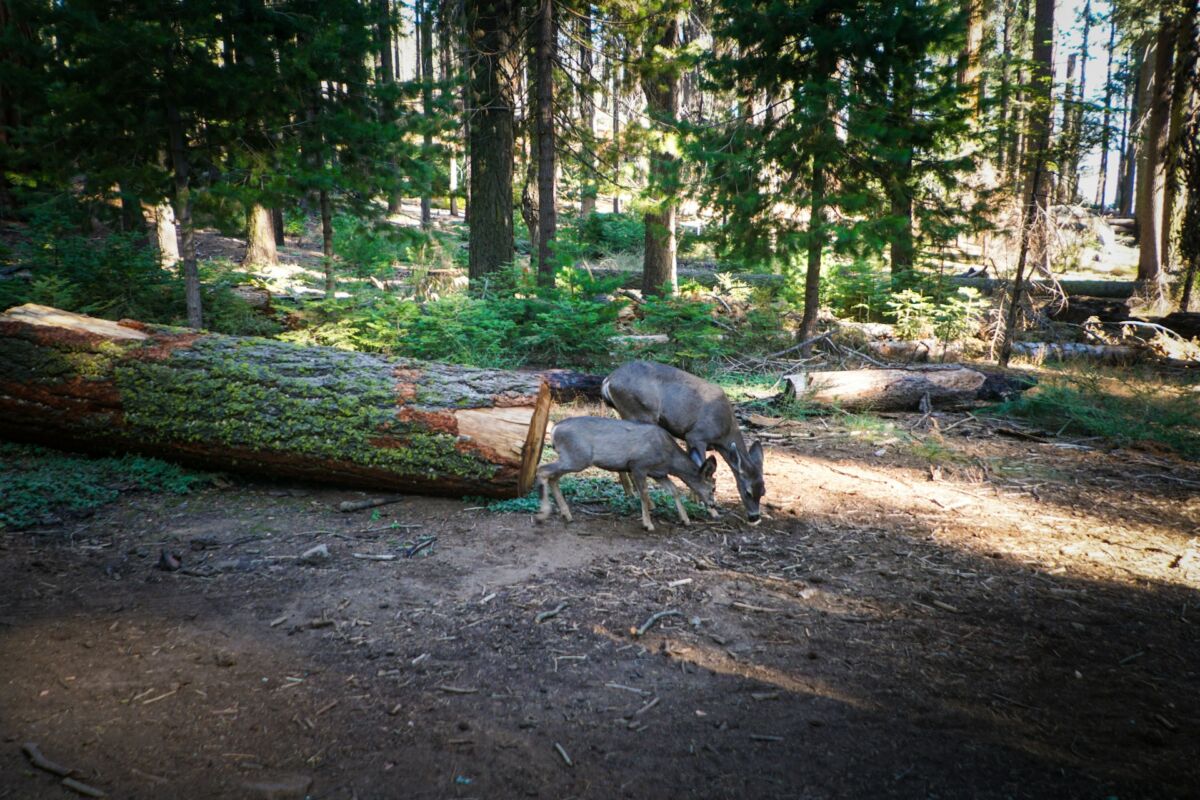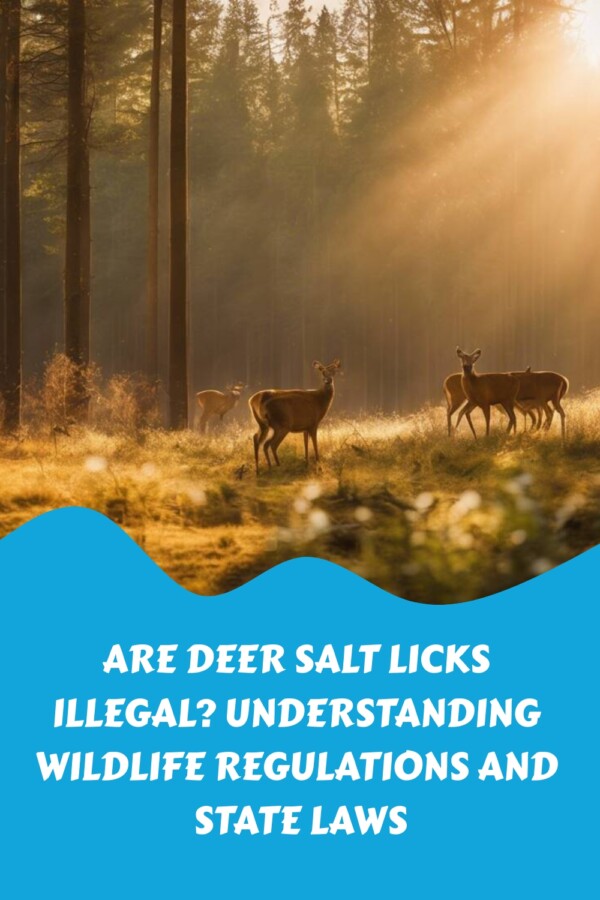No, deer salt licks are not generally illegal. They are widely used across various states for observing and taking pictures of wildlife. However, their use in hunting can sometimes be subject to certain restrictions. Indeed, state laws on this matter differ considerably – Alabama allows the use of mineral blocks for attracting deer whereas Alaska doesn’t permit the use of salt licks for hunting. Always remember, knowing about the rules in your specific location is key. Now, let’s delve deeper into the topic.
In some states, the use of salt licks for deer may be illegal due to concerns about spreading Chronic Wasting Disease (CWD). It is essential to be well-versed in your state’s regulations regarding salt licks and other baiting practices to ensure compliance with wildlife conservation laws.
Are Deer Salt Licks Legal?

Richard Webb / Wikimedia Commons, CC BY-SA 2.0
Deer salt licks can serve different purposes, and their legality depends on their intended use and specific state laws. In most states, using salt licks for observing and photographing wildlife is permitted, as it provides an opportunity to enjoy and document the natural behavior of deer and other wildlife. However, when it comes to hunting purposes, regulations can be more stringent, and the legality of using salt licks may vary widely.
When it comes to hunting, attracting deer using salt licks can be controversial due to ethical and safety concerns. Some argue that the use of salt licks for hunting gives an unfair advantage to hunters, creating an artificial lure that disrupts the natural behavior of deer. On the other hand, proponents may argue that using salt licks for hunting allows for easier management of wildlife populations and aids in creating a sustainable ecosystem.
For instance, in some states like Alabama, hunters are allowed to use salt licks to attract deer during hunting season. Conversely, California prohibits the use of salt licks for hunting deer. It’s crucial for hunters to be fully informed about their state’s regulations regarding salt lick use when planning a hunting trip.
Additionally, hunters need to be aware of potential risks associated with using salt licks in deer habitats. For instance, salt licks can contribute to the spread of Chronic Wasting Disease (CWD), a fatal neurological disease affecting deer populations.
Understanding the nuances of regulations pertaining to deer salt licks is crucial to ensure compliance with the law while also promoting ethical and responsible behavior towards wildlife.
State-Specific Regulations on Deer Lures
When it comes to wildlife regulations, each state has its own unique set of rules that govern the use of deer lures and salt licks. These regulations can vary widely, so it’s important to thoroughly research and understand the specific laws in the state where you plan to use deer lures. Let’s take a closer look at how different states approach this issue.
For instance, in some states like Alabama, using mineral blocks to attract deer is perfectly legal. However, if we turn our attention to Alaska, the use of salt licks for hunting purposes is not allowed at all. Such stark differences in regulations highlight the need for hunters and wildlife enthusiasts to be well-informed about the laws governing wildlife attractants in their specific area.
Researching State Regulations

Benjamin Dada / Unsplash
As a responsible hunter or wildlife enthusiast, it’s essential to thoroughly research and understand the specific guidelines and restrictions related to deer lures in any state where you plan to engage in these activities. Failure to comply with these regulations can result in significant legal consequences, so it’s crucial to stay informed and abide by the laws.
To illustrate further, if you’re planning a hunting trip that spans multiple states, you’ll need to be aware of the differing regulations in each location. What’s allowed in one state may be prohibited in another, and failing to make this distinction could lead to unintentional violations of wildlife laws.
Consult Local Authorities

English: Jacob W. Frank / Wikimedia Commons, Public domain
One effective way to ensure compliance with wildlife regulations is to consult with local wildlife authorities or the Department of Natural Resources. These are valuable sources of information that can provide clarity on the specific laws and restrictions pertaining to deer lures and salt licks in your area.
Remember: Regulations can change over time due to shifts in wildlife management priorities or emerging environmental concerns.
Understanding and adhering to state-specific regulations on deer lures is essential for hunters and wildlife enthusiasts. Now, let’s navigate through the intricacies of using deer attractants on private versus public lands.
Accessibility and Use of Deer Lures on Private vs Public Lands

Richard Webb / Wikimedia Commons, CC BY-SA 2.0
When it comes to using deer lures, the location makes a significant difference. On public lands, using salt licks or other attractants may be strictly regulated or even prohibited in some states. This regulation aims to prevent habitat degradation and ensure fair treatment of all hunters, without one gaining an unfair advantage by using artificial attractants. It aligns with the idea of preserving natural habitats and ensuring that wildlife has equal access to resources.
Private lands might have different rules regarding the use of deer lures. Private landowners often have more freedom in managing their properties and can decide whether to allow or restrict the use of salt licks and attractants for hunting purposes. In some cases, they might even use salt licks as a way to attract deer for wildlife observation rather than hunting. It’s important for hunters and landowners to be aware of the specific regulations in their area to ensure compliance with the law.
For instance, in certain states where baiting is allowed on private lands but not on public lands, it’s essential for hunters to be mindful of where they are hunting and what regulations apply. It’s a nuanced issue that requires a good understanding of local laws and practices.
Differentiating between the regulations on private and public lands is crucial for anyone involved in hunting or wildlife observation. By understanding these differences, people can ensure that they are operating within legal boundaries while also contributing to the conservation efforts targeted at protecting natural habitats and wildlife populations.
Understanding wildlife regulations is a crucial aspect of responsible hunting. Now, let’s turn our attention to exploring the legal implications surrounding hunting with bait and attractants.
Legal Implications of Hunting with Bait and Attractants
The use of attractants such as salt licks and bait for hunting has been a topic of debate and scrutiny in wildlife management and hunting regulations. Laws and regulations regarding the use of attractants vary by state, and it’s crucial for hunters to be aware of and comply with these laws to avoid facing fines or penalties.
Some states strictly prohibit hunting over bait, while others have specific guidelines and regulations that permit its use under certain conditions. It’s vital for hunters to research and understand the laws specific to their location. For instance, Alabama allows baiting for deer and wild hog hunting on private land with the purchase of a baiting license, while Michigan recently rescinded some of its baiting regulations in certain counties in the Upper Peninsula, allowing hunters to hunt over bait for a limited period.
Understanding the legal implications involves more than just knowing whether baiting is allowed. Hunters must also familiarize themselves with the designated types and quantities of bait or attractants permitted, as well as any reporting or licensing requirements associated with their use. Additionally, chronic wasting disease (CWD) is a concern in certain areas, leading to surveillance measures and regulations regarding the transportation and use of deer attractants in an effort to prevent the spread of this disease.
In Minnesota, feeding bans have been lifted in several counties, allowing feeding and attractants to be used for deer hunting. The specific locations where the ban has been lifted include Aitkin, Carlton, Chisago, Clearwater, Douglas, and more. This exemplifies how wildlife management departments are constantly reevaluating and modifying regulations based on various ecological and conservation factors.
Given the evolving nature of hunting regulations and the diverse habitat requirements for wildlife conservation, it’s essential for hunters to stay informed about changes in state laws governing the use of attractants. By staying updated on these regulations, hunters can contribute to sustainable wildlife management practices while also abiding by legal requirements.
Being knowledgeable about the laws regarding baiting and attractants not only ensures legal compliance but also supports responsible hunting practices aligned with conservation efforts.
Potential Risks of Deer Salt Licks
Deer salt licks can act like magnets for a variety of wildlife, not just deer. Setting out a salt lick in your yard or nearby wooded areas can draw in creatures you didn’t intend to welcome. While seeing birds and small animals flocking to your property might seem charming at first, it’s not all picturesque; it can cause an imbalance in the local ecological system.
Foragers Beware! The presence of salt licks can entice animals that wouldn’t normally venture into an area, leading to overuse of certain spots. This can upset the balance of foraging and grazing patterns, potentially impacting the local flora and fauna. Over time, this often leads to overgrazing, disturbing native vegetation and bringing unexpected changes to the ecosystem.
Impact on Wildlife Health: As appealing as they may be to wildlife, excessive salt licks pose a significant health risk to these creatures – especially deer. While deer do need a bit of sodium in their diet, too much of a good thing is never beneficial.
To put it into perspective, imagine craving some potato chips or popcorn – a little salt is okay (and delicious), but too much makes you feel unwell. It’s quite similar for deer and other wildlife. When they have unrestricted access to salt licks, they end up consuming far more sodium than their bodies actually need, which can be harmful to their overall health. This excessive intake can lead to dehydration and problems with their kidneys and digestive system.
In essence, while providing salt licks for deer may seem harmless or even helpful, it’s essential to consider the broader impact on the environment and wildlife before setting them out. Good intentions might lead to unintended consequences.
Recognizing these potential risks allows us to be mindful of how we interact with nature and make informed decisions that prioritize the wellbeing of our local ecosystem.
Legalities of Using Wildlife Attractants in General
When it comes to wildlife attractants, it’s not just about deer. There are regulations and guidelines regarding the use of attractants for other wildlife species as well. Each state may have its own rules and laws concerning these substances due to their potential impact on the local ecosystem. It’s important to be aware of these regulations to avoid unwittingly contributing to ecological disruptions.
For example, certain wildlife attractants may entice animals closer to human settlements, increasing the risk of conflicts with humans and pets. Moreover, some substances might not break down easily, leading to environmental contamination that could harm both wildlife and their habitats.
It’s no surprise that government agencies are keen on keeping a check on these practices. By understanding and adhering to local laws and guidelines, individuals can play a crucial role in maintaining a balanced and healthy environment for both wildlife and humans.
State Examples

Patrick Mayor / Unsplash
In California, for instance, regulations exist to limit the usage of toxic substances as attractants to protect both flora and fauna. Conversely, states like Alaska have implemented restrictions on attractants such as baiting or scent-based lures for specific game hunting.
Before using any form of wildlife attractant or feed, whether for hunting, photography, or other purposes, it’s essential to research and understand the relevant laws in your area. Ignorance of these regulations is not an excuse and could potentially lead to unintended consequences.
Staying informed about local laws can help prevent unintentional harm to wildlife and ecosystems while enjoying the benefits that responsible interaction with nature brings.
Understanding the laws surrounding wildlife attractants is vital in ensuring the protection of both wildlife and their habitats. Always staying abreast of regulations can foster harmonious coexistence between humans and wildlife.



